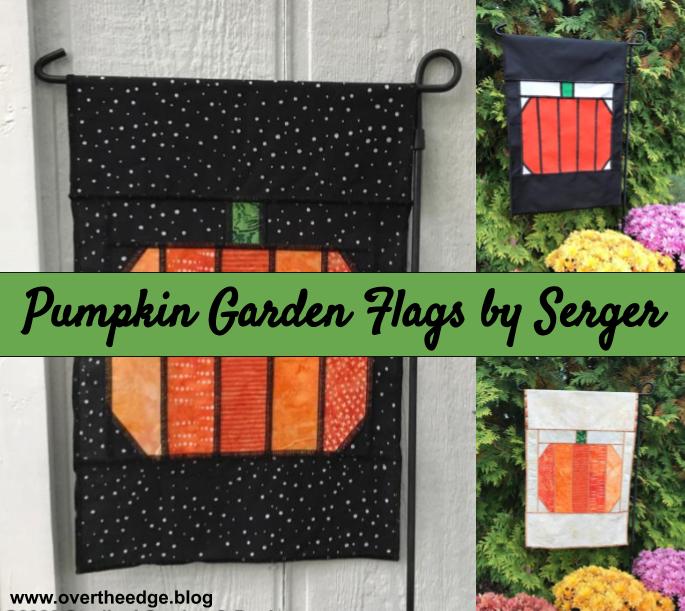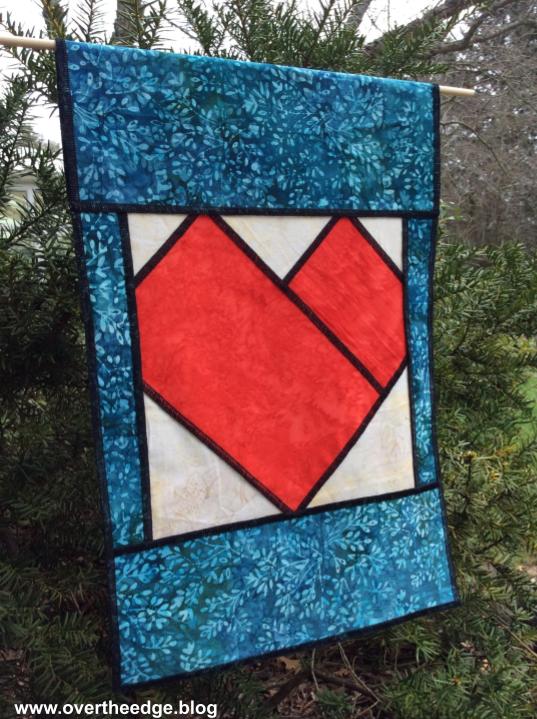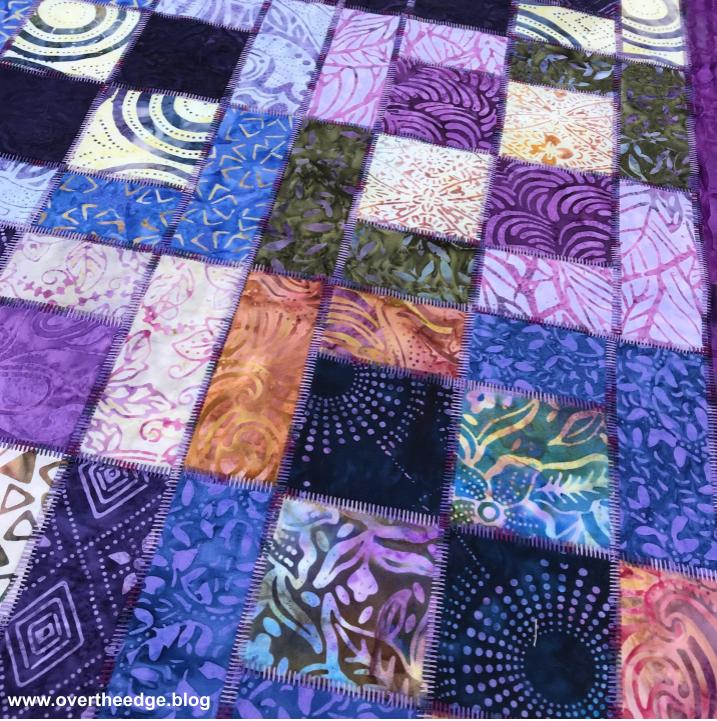Make a Serger Charm Table Runner
Serger Charm Table Runner
I finally completed the official pattern for my Serger Charm Table Runner design. It’s hard to believe that six years have passed since I first taught this design in a serger class. It’s time to get charmed by a serger!
My serger charm table runner quilt is made from charm squares that are pieced together with a serger flatlock stitch. It even has overlock embellished binding. I included all three layouts and applique shapes in the pattern: Winter Skies, Hearts a Flutter and Falling Leaves. And of course, the step by step instructions have lots of diagrams and photographs. Keep reading to learn all about the table runners I made as samples for my pattern.
The Flatlock Stitch and Piecing a Quilt
There are many different ways to use a flatlock stitch. Most involve serging with part of the loops hanging off the edge of the fabric. You need a steady hand (or a special presser foot) and a little practice to get it just right. But with flatlock piecing you don’t need a special foot. Your standard presser foot will work just fine. You guide the raw edges of your fabric next to your blade, and just trim off the stray threads. So the entire stitch lays on the fabric with no overhanging loops.
Flatlock piecing is a great introduction to using a flatlock stitch. For more information visit my tutorial, Master the Three Thread Flatlock Stitch for Quilt Piecing at https://overtheedge.blog/tutorials/master-the-three-thread-flatlock-stitch-for-quilt-piecing/
Fabric Charm Squares
Charm squares are 5” squares that are cut from a collection of cotton quilting fabric and sold in packages. There are typically 40-42 squares per pack, but the number can vary. I used one package of charm squares for each of my table runners.
- Winter Skies – I used a Northcott Toscana Evening Shadow Chip Pack
- Hearts a Flutter – I used a Moda French General Favorites Charm Pack
- Falling Leaves – I used a Moda Hello Fall by Sandy Gervais Charm Pack
Both the background squares and the applique squares in my table runners came from the charm packs. The Northcott Toscana charm pack had 5 colors in it with multiples of each fabric. The Moda Hello Fall charm pack had very few repeats. The Moda French General Favorites charm pack had some repeats. You can always add in some applique fabric from your stash if the charm pack doesn’t have the solids or blenders you need for the appliques. I was lucky because the charm packs I chose had just the right amount of blenders for appliques. Or you could always cut your own collection of 5” squares for this table runner.
Quilt Top
The table runners were pieced together using flatlock stitch. I love the look of the flatlock stitches in decorative quilts where the thread can be a focal point. And I love the way it looks with variegated thread. It really adds interest to a quilt. I’ve used both 30 wt and 40 wt variegated cotton threads by Sulky and YLI. The squares with the flatlocked seams look great as a background for applique.
Applique
I had fun designing the applique shapes for this pattern. Real tree leaves were the inspiration for my Falling Leaves table runner. It’s amazing what you can do with real leaves and a copy machine! I learned how to make my own six sided paper snowflakes and picked my favorites to add to my Winter Skies table runner. For the Hearts a Flutter table runner I cut out several different paper hearts from folded paper and tested them on the runner before choosing my favorite.
I used the raw edge applique technique to apply my shapes using a sewing machine. But other forms of applique would also work. If you have a serger with a large throat space you could applique with the chain stitch. You could even machine embroider some of your favorite applique designs on your table runner.
Batting
Choose your favorite. I’ve made mine with thin fusible fleece, cotton quilt batting, and flannel. I like them all, but each is a little different. Flannel is the thinnest. Fusible fleece was a little more “stiff” and cotton quilt batting was the fluffiest. I think the fusible fleece fused to the back side of the quilt top fabric helps to hold the fabric and flatlock stitches in place, but I’ve had good success with all of these battings.
Quilting
You can quilt this table runner with as little or as much quilting as you like, based on your selected batting. Some battings require quilting stitches every 3-4” or some like flannel can be quilted 8-10” apart. My table runners are decorations and are spot cleaned as needed (rarely), so quilting distances are not that important. I did minimal quilting on my table runners so that my variegated thread and flatlock stitches would stand out and be a focal point of the quilts. I quilted my table runners using both a sewing machine and a hand sewing needle.
Binding
Although any method of binding would work for this table runner, I chose to embellish my binding with a three thread overlock stitch. The serger stitches on the binding really help tie together the quilt with the flatlock stitching around the squares. I attached and top stitched the binding to these table runners using a sewing machine, but a serger using a 4 thread overlock and/or a chain stitch would work as well.
Other Ways to Use a Serger for this Project
You can serge a table runner just like mine using the instructions in the pattern. A standard serger capable of a three thread flatlock stitch and a sewing machine are all you need.
Would you like to get more creative with your serger? Here are a few additional ways to use your serger that are not included in the pattern:
- Use a rolled hem on the binding instead of an overlock
- Attach the binding with a four thread overlock stitch or a chain stitch
- Use a chain stitch to top stitch the binding
- Stitch your applique using a chain stitch
For tips about quilting with a chain stitch, see my blog post “How to Serge a Quilt with a Chain Stitch” at https://overtheedge.blog/how-to-serge-a-quilt-with-a-chain-stitch/ and my tutorial “Tips for Serging with a Chain Stitch” at https://overtheedge.blog/tutorials/tips-for-serging-with-a-chain-stitch/.
Get Charmed by a Serger Today!
If you’d like to try making the Serger Charm Table Runner be sure to visit my etsy shop and get your own copy of my pattern. Use the coupon code SERGERCHARMNOV2021, which will give you a 20% discount on this pattern through November 30, 2021. Click on this link to take you directly to the pattern section of my shop. https://www.etsy.com/shop/studiojsewing?coupon=SERGERCHARMNOV2021
I hope you enjoyed learning about the making of my serger charm table runners.

Resources
Tutorial – Master the Three Thread Flatlock Stitch for Quilt Piecing https://overtheedge.blog/tutorials/master-the-three-thread-flatlock-stitch-for-quilt-piecing/
Serger Charm Table Runner Patterns https://www.etsy.com/shop/studiojsewing


















